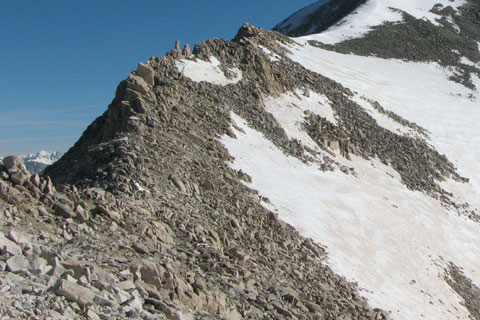| 373 | Moving Over Loose Stones | 2011-04-08 |

Mount Antero's loose rocks
Mountains are constantly rotting away. The heat, cold, wet, and dry, help loosen the rocks and ready them to launch down the slope. Then, one false step and the rocks are ready to fly. The sailing rocks do not care if someone is in their path. It could be an eighteen year old man, which I still call a teenager..., a nine year old boy, or you - anyone in the rock's path will be hit.
On a rock climb, in a State Park, my friend and I were discussing the loose rocks of a new climb. That day everything we touched seemed to be loose. A visitor overheard our complaining and went to the Park Office to report the loose rocks. They wanted someone to remove the loose rocks before a climber got hurt. Having someone remove all of the loose rocks would have been great; but the problem was I was climbing with the Park Ranger who was in charge of rock climbing and high angle rescue for the Park. We would have been the ones who would have had to clear the rocks. We decided it was a better idea to go somewhere else to climb.
Loose rocks are everywhere. Some rocks fall on their own and some are assisted. As hikers, climbers, and mountaineers we might not intentionally knock a rock off; but regardless of intent, we do not want anyone to be hurt. So, be careful.
A few tips to avoid those tumbling rocks ...
Be aware of your surroundings. Is the rock loose? Are there hikers above me? Are there hikers below me?
Test holds. Test both hand and foot holds. If you touch any rocks, make sure the rocks are solid before moving on them.
Watch for loose rocks along the trail. You don't want to kick them off; but you also don't want to step on them and have them roll beneath your feet.
Never throw rocks or anything else off a cliff.
If a rock (or other object falls) yell, "rock".
If someone yells "rock" from above, don't look up to see where the rock is falling. Quickly duck and if possible move to a sheltered area. Protect your head.
Step softly. Place each step.
Try to predict what is going to happen to the rock when you step on it. After a while, this practice will become second nature.
Practice. The more loose rocks you walk on the better you become at navigating the menacing slopes.
If you see the hiker above you is having trouble with loose rocks, make sure you are not below him.
When you come across loose rocks on the edge of the trail etc, that look as if they could fall to the trail below, take a few seconds and re-place the rocks to a better location.
If you do not walk well in areas with loose rocks, it might not be a bad idea to avoid such areas.
Traveling across loose rocks is possible; but it takes discipline to move softly and smoothly.
Happy safe trails.